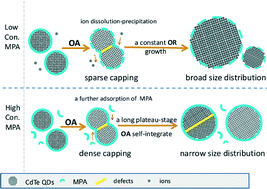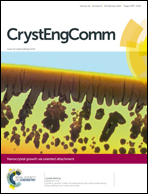Growth kinetics study revealing the role of the MPA capping ligand on adjusting the growth modes and PL properties of CdTe QDs
Abstract
So far, the photoluminescence (PL) properties optimization of mercaptopropionic acid (MPA) capped CdTe has yet to be understood from a perspective of growth kinetics. In this work, the growth kinetics, size distribution and PL properties of CdTe quantum dots (QDs) grown in MPA aqueous solutions of two extreme concentrations, i.e. 0 mM and 50 mM, were systematically investigated. The studies revealed that CdTe QDs coarsen in low and high concentrations of MPA followed different growth kinetics, i.e. a mixed OA (Oriented Attachment)–OR (Ostwald Ripening) growth and an OA dominated growth, respectively. Moreover, the OR growth in a low MPA concentration solution was found to be disadvantageous for narrowing the size distribution but favourable for enhancing fluorescence, while the OA growth in a high MPA concentration solution is beneficial for focusing and controlling the particle size. Further activation energy calculations indicate that the extra MPA that forbids the OR growth and retards the OA growth is favourable for slowing the particle growth, thus achieving CdTe QDs with a controlled size and narrow distribution. Furthermore, the kinetics study reveals how the introduction of concentrated surface ligands affects the PL properties (FWHM and intensity) of the material.

- This article is part of the themed collection: Nanocrystal growth via oriented attachment

 Please wait while we load your content...
Please wait while we load your content...